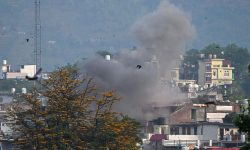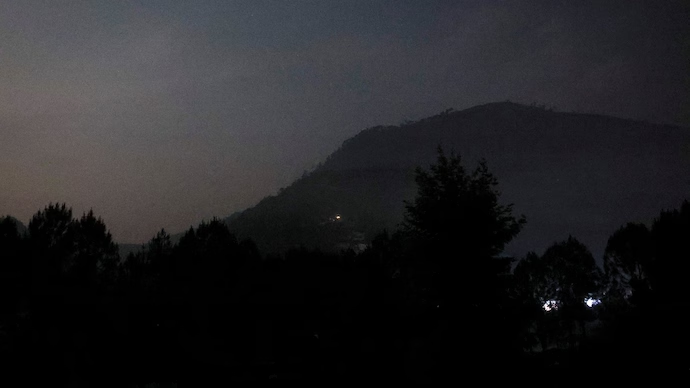Dakashinkali, Goddess of Blood and Power

Worthy to her name by the goddess, Dakashinkali has black complexion whose thirst for blood is never quenched. she has a formidable appearance, with a necklace of human skills hung round her necklace of human skills hung round her neck and the ever portending red tongue to test the blood of those goats and chickens that are sacrificed on hereafter.
The goat is forced onto the executioner’s thigh and his left hand pushes up the animal’s chin to make the neck taut. His right hand clasps a long knife newly wiped clean on the carcass of another goat, which lies headless and twitching., The knife flashed and there is gurgle as a fresh red stream spurts on to the stone image of the goddess kali, already drenched in sacrificial blood. The anger of the terrible goddess is once again appeased. Once again a wish will fulfilled .
A strong stench of sweat and raw blood arises, in nauseating contrast to the sweet tang of incense and burning oil. The courtyard’s sole outlet is blocked. A deep puddle of dark, stick blood stands sullenly beneath a row of three stone images. Prayers and pleas are muttered. Showers of rice and the brightly coloured petals of marigolds hit the copper shade that houses the stone image of kali, and devotees struggle to touch her feet. Mothers, their eyes clamped shut and lips twitching, clasp their children.
The temple executioners bargain, stuffing blood-soaked rupee notes roughly in to stained pockets. Priests chant passages culled from the furthest realms of antiquity. A headless chicken is placed in to the hands of a curious child, who calmly in another. And all the while, dripping with the blood of countless animals, the terrible kali looks on.
The temple of the goddess, situated some sixteen kilometers from the city of Kathmandu, rests in a quiet cove amidst sylvan surroundings on the southern ridge of the valley.
The temple evinces on aesthetic charm and is drab and punt. After a steep flight of stairs lined with beggars and ash- smothered ascetics, there is a row of dingy teashops, damp resthouses and a bridge leading to the main courtyard where the actual sacrifices take place. To the south of the courtyard is a small tributary of the Bagmati, blocked by a newly- constructed concrete dam, which gives rise to a mall pool in which devotes clean and cut the carcasses of their offerings. Unlike most Nepalese temples, Kali’s is barren and severe. No intricate carvings adorn its walls and roof. Its only decoration is the small mural of colorful peacocks which stands directly above each deity. But it is faith, rather than aesthetics, which prompts hundreds to enter the tiny courtyard on the Tuesdays and Saturdays of each week, breaks the serene promise of the temple’s natutal setting, sendings the blood flowing in a stream from the headless carcasses of a hundred goats and chickens, ducks and buffalo to redden the nameless brood which carries it down to the restless brown waters of the holy Bagmati below.
Kali, who can command such faith, is the most awesome and powerful goddess in the Hindu Pantheon. Bestowed with tremendous vigour and strength, and endowed with a wrath which matches both, she is seen as a horrific manifestation of gentle Parvati,, comely consort of the lusty Lord Shiva. As the quadra- handed goddess of dark mysteries, kali is usually depicted as being black in colour, with a garland of human skulls around her neck.
How and when the Dakshinkali sanctuary was established is veiled in a shroud of obscurity and doubt, but it is believed that the 17 century king, Raja Pratap Malla, was responsible for installing the image of kali through instructions received in a dream. Tradition says that the king at first ignored the instructions, but that later, threatened by the outbreak of an epidemic, he hastened to construct the image which today still stands directly opposite to the courtyard. The sacrificial animal is regarded as fortunate, and is picked some time in advance of the sacrifice itself. A red tikka is smeared across its forehead and water sprinkled upon it. When the animal shakes itself, in an attempt to be rid of the water, this is believed to denote consent. It is this instinctive gesture that results in its death. After the throat is slit and the blood offered to kali, the sacrifice is held firmly to the floor and devotees place duna, small containers usually made from banana leaves, around the carcass inorder to collect the remaining blood, which is preserved as prased and decreed holy. The head is then completely serverd and handover to the animal’s owner.
Religious practices are often unconcerned with rational justification, as are certain aspects of traditional or ethics. The seemingly senseless slaughter of the animals amy evoke mixed emotions from Western observers, who may condemn it as ‘uncouth’, ‘primitive’, or ‘ghastly’. For the devout Hindu however, no doubt with blood sacrifice, is refered as ‘Mother’ or ‘Grandmother’. She is worshipped as the averter of evil, a guardian, and a source of hope.
The sight of blood and mutilated animals however, is not all that a visit to her temple has to offer. The 45 minute drive to Dakshinkali is punctuated by countless sites of great beauty and historical and mythological significance. The visitor will pass Chovar Gorge, the Kathmandu Valley’s only water outlet where according to legend, Manjusree with his magic sword hewed an opening to drain the Valley, which was at that time, a huge lake. He will pass Lake Toudaha, the legendary habitat of kortotal Naga, a colossal serpent who is still suspected to dwell there. He will pass by the pagoda- styled Seku Naryan temple, dedicated to Lord Vishnu, where he can watch sholas of fish swim in the cool, clear waters of the pools below. He will pass jai Vinayak, a temple dedicated to the Elephant god, Ganesh, which is sheltered by the shoulder of a knoll and stands just above the swirling waters of the Bagmati river. And, should the sight of religious artistry become trying, he can lose himself in the miles of terraced fields that fringe the mountains or watch the sunlight play on the waters of the Bagmati below, following with his eyes the narrow red paths which appear to meander in to infinity, or the dust setting on the leaves of the trees which stand by the road. He will see woman as they bathe, their naked children scampering noisily beside the dhara, or spring which flows by the dusty, brown bricked thatched villages which are their homes.
And all the while, not far away, amidst the squawking chickens and the cries of restless goats, the menacing round eyes of kali steeped in blood and unshakeable faity, look on. As before. As always.
-Mariya GC










 भारतको पञ्जाव प्रान्तमा पनि विस्फोट
भारतको पञ्जाव प्रान्तमा पनि विस्फोट जम्मु कश्मिरमा ‘ब्ल्याकआउट’, ठूलो विस्फोटकाे आशंका
जम्मु कश्मिरमा ‘ब्ल्याकआउट’, ठूलो विस्फोटकाे आशंका मन्त्रिपरिषद् बैठकअघि ओली र देउवाबीच छलफल
मन्त्रिपरिषद् बैठकअघि ओली र देउवाबीच छलफल सुशासन कायम गर्ने मुख्यमन्त्री शाहको प्रतिबद्धता
सुशासन कायम गर्ने मुख्यमन्त्री शाहको प्रतिबद्धता गाजामा सहायता रोकिनु अन्तर्राष्ट्रिय मानवीय कानुनविपरीत : रेड क्रस
गाजामा सहायता रोकिनु अन्तर्राष्ट्रिय मानवीय कानुनविपरीत : रेड क्रस मेट गालाको रेड कार्पेटमा डेब्यू गरेर शाहरूखले रचे इतिहास
मेट गालाको रेड कार्पेटमा डेब्यू गरेर शाहरूखले रचे इतिहास धरहरा कप खुल्ला फुटसल प्रतियोगिता जेष्ठ ३० र ३१ गते हुँदै
धरहरा कप खुल्ला फुटसल प्रतियोगिता जेष्ठ ३० र ३१ गते हुँदै रोनाल्डोका छोरा रोनाल्डो जुनियर पोर्चुगलको यू-१५ राष्ट्रिय टोलीमा
रोनाल्डोका छोरा रोनाल्डो जुनियर पोर्चुगलको यू-१५ राष्ट्रिय टोलीमा भारतद्वारा पाकिस्तानमाथि सैन्य कारबाही सुरु , तनाव चुलियो
भारतद्वारा पाकिस्तानमाथि सैन्य कारबाही सुरु , तनाव चुलियो जन्ती पुर्याएर फर्किएको बस नदीले बगायाे
जन्ती पुर्याएर फर्किएको बस नदीले बगायाे
प्रतिक्रिया